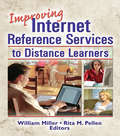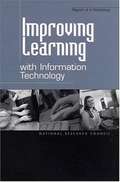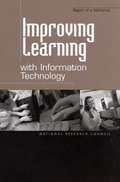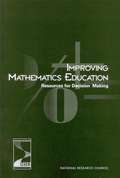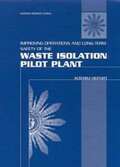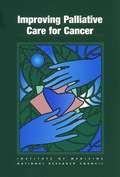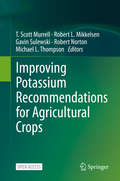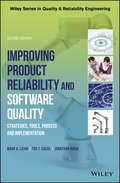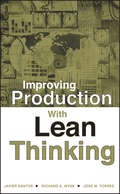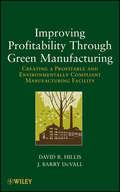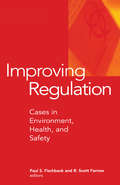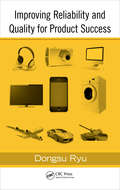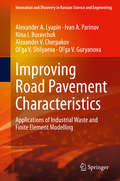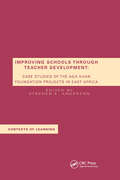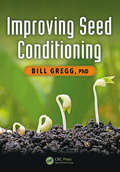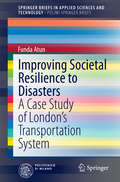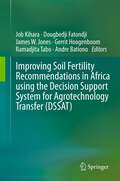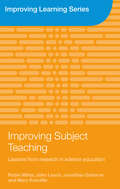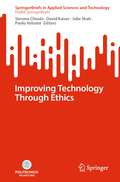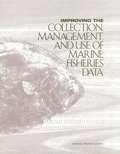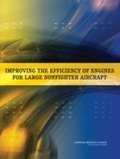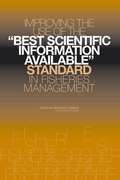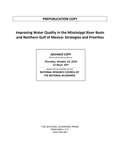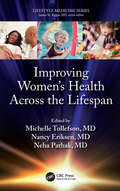- Table View
- List View
Improving Internet Reference Services to Distance Learners
by William Miller Rita PellenIn their efforts to provide distance learners with the most effective services possible, librarians and information specialists are working more and more with faculty in academic departments, IT departments, and other librarians at cooperating institutions. Improving Internet Reference Services to Distance Learners chronicles how those efforts have seen librarians become actively involved in online course management and delivery systems, particularly Blackboard, Desire2Learn, and WebCT, or by "embedding" themselves into the online course structure to better learn where students need assistance. This invaluable resource also examines how librarians use Internet resources to support professional and continuing education and to establish university-wide information and referral services to provide quality service to distance learners.Improving Internet Reference Services to Distance Learners encourages librarians to think more broadly about working with "outside" individuals when designing and providing reference and other services to nontraditional users. The book examines why it&’s best to consider user needs, funding, staff management, and collaboration development when planning Internet reference services, how to develop and implement a required, credit-bearing online information literacy course, and how to apply effective marketing techniques from the business world to increase awareness of reference support services available to distance learners. It also offers a look at the Walden University Library at Indiana University-Bloomington, which "houses" no print collection-only online databases-and includes case studies that document the design and development of Internet reference services for the University of Illinois&’ Fire Service Institute, and the efforts to provide support for doctor of pharmacy students at the University of Wisconsin-Madison in their final year of study. Improving Internet Reference Services to Distance Learners provides practical information on: monitoring online discussion threads devoted to library research Web-based interactive tutorials integrating library services in support of coursework integrating library services into online courses offering, promoting, and providing instruction to public users, as well as local and distance students developing a web site that centralizes information about library services and resources the potential of the academic library to be the central provider of information and referral services for an entire universityImproving Internet Reference Services to Distance Learners is an invaluable resource for librarians working in academic, school, special, and public settings, and for library science faculty and students.
Improving Learning with Information Technology: Report of a Workshop
by Steering Committee on Improving Learning Information TechnologyA report on Improving Learning with Information Technology
Improving Learning with Information Technology: Report of a Workshop
by National Research CouncilIn spring 2000, representatives from the U. S. Department of Education (DOEd) and senior staff at the National Research Council (NRC) recognized a common frustration: that the potential of information technology to transform K-12 education remains unrealized. In fall 2000 the U. S. DOEd formally requested that the National Academies undertake an interdisciplinary project called Improving Learning with Information Technology (ILIT). The project was launched with a symposium on January 24-25, 2001. This report summarizes the proceedings of the symposium and is intended for people interested in considering better strategies for using information technology in the educational arena. While it offers insights from the presenters on both the challenges to and the opportunities for forging a better dialogue among learning scientists, technologists, and educators, it does not contain conclusions or recommendations. Rather, it highlights issues to consider, constituents to engage, and strategies to employ in the effort to build a coalition to harness the power of information technologies for the improvement of American education. Every effort has been made to convey the speakers' content and viewpoints accurately. Recognizing the speculative nature of many of the speaker contributions, most attributions identify a speaker by area of expertise rather than by name. The report reflects the proceedings of the workshop and is not intended to be a comprehensive review of all the issues involved in the project to improve learning with information technology.
Improving Mathematics Education: Resources for Decision Making
by Committee on Decisions That CountA report on Improving Mathematics Education
Improving Operations And Long-term Safety Of The: Interim Report
by National Research CouncilThe National Academies Press (NAP)--publisher for the National Academies--publishes more than 200 books a year offering the most authoritative views, definitive information, and groundbreaking recommendations on a wide range of topics in science, engineering, and health. Our books are unique in that they are authored by the nation's leading experts in every scientific field.
Improving Palliative Care for Cancer
by Institute of MedicineIn our society’s aggressive pursuit of cures for cancer, we have neglected symptom control and comfort care. Less than one percent of the National Cancer Institute’s budget is spent on any aspect of palliative care research or education, despite the half million people who die of cancer each year and the larger number living with cancer and its symptoms. Improving Palliative Care for Cancer examines the barriers—scientific, policy, and social—that keep those in need from getting good palliative care. It goes on to recommend public- and private-sector actions that would lead to the development of more effective palliative interventions; better information about currently used interventions; and greater knowledge about, and access to, palliative care for all those with cancer who would benefit from it.
Improving Potassium Recommendations for Agricultural Crops
by Michael L. Thompson Robert Norton T. Scott Murrell Robert L. Mikkelsen Gavin SulewskiThis open access book highlights concepts discussed at two international conferences that brought together world-renowned scientists to advance the science of potassium (K) recommendations for crops. There was general agreement that the potassium recommendations currently in general use are oversimplified, outdated, and jeopardize soil, plant, and human health. Accordingly, this book puts forward a significantly expanded K cycle that more accurately depicts K inputs, losses and transformations in soils. This new cycle serves as both the conceptual basis for the scientific discussions in this book and a framework upon which to build future improvements. Previously used approaches are critically reviewed and assessed, not only for their relevance to future enhancements, but also for their use as metrics of sustainability. An initial effort is made to link K nutrition in crops and K nutrition in humans. The book offers an invaluable asset for graduate students, educators, industry scientists, data scientists, and advanced agronomists.
Improving Product Reliability and Software Quality: Strategies, Tools, Process and Implementation (Quality and Reliability Engineering Series)
by Mark A. Levin Ted T. Kalal Jonathan RodinThe authoritative guide to the effective design and production of reliable technology products, revised and updated While most manufacturers have mastered the process of producing quality products, product reliability, software quality and software security has lagged behind. The revised second edition of Improving Product Reliability and Software Quality offers a comprehensive and detailed guide to implementing a hardware reliability and software quality process for technology products. The authors – noted experts in the field – provide useful tools, forms and spreadsheets for executing an effective product reliability and software quality development process and explore proven software quality and product reliability concepts. The authors discuss why so many companies fail after attempting to implement or improve their product reliability and software quality program. They outline the critical steps for implementing a successful program. Success hinges on establishing a reliability lab, hiring the right people and implementing a reliability and software quality process that does the right things well and works well together. Designed to be accessible, the book contains a decision matrix for small, medium and large companies. Throughout the book, the authors describe the hardware reliability and software quality process as well as the tools and techniques needed for putting it in place. The concepts, ideas and material presented are appropriate for any organization. This updated second edition: Contains new chapters on Software tools, Software quality process and software security. Expands the FMEA section to include software fault trees and software FMEAs. Includes two new reliability tools to accelerate design maturity and reduce the risk of premature wearout. Contains new material on preventative maintenance, predictive maintenance and Prognostics and Health Management (PHM) to better manage repair cost and unscheduled downtime. Presents updated information on reliability modeling and hiring reliability and software engineers. Includes a comprehensive review of the reliability process from a multi-disciplinary viewpoint including new material on uprating and counterfeit components. Discusses aspects of competition, key quality and reliability concepts and presents the tools for implementation. Written for engineers, managers and consultants lacking a background in product reliability and software quality theory and statistics, the updated second edition of Improving Product Reliability and Software Quality explores all phases of the product life cycle.
Improving Production with Lean Thinking
by Richard A. Wysk Jose M. Torres Javier SantosUnique coverage of manufacturing management techniques--complete with cases and real-world examples. Improving Production with Lean Thinking picks up where other references on production processes leave off. It is increasingly important to integrate and systematize lean thinking throughout production/manufacturing and the supply chain because the market is becoming more competitive, products are becoming more complex, and product life is getting shorter and shorter. With a practical focus, this book encompasses the science and analytical background for improving manufacturing, control, and design. It covers specific methodologies and tools for: * Material flow and facilities layout, including a six step layout design process * The design of cellular layouts * Analyzing and improving equipment efficiency, including Poka-Yoke, motion study, maintenance, SMED, and more * Environmental improvements, including 5S implementation With real-life case studies of successful European and American approaches to lean manufacturing, this reference is ideal for engineers, managers, and researchers in manufacturing and production facilities as well as students. It bridges the gap between production/manufacturing and supply chain techniques and provides a detailed roadmap to improved factory performance.
Improving Profitability Through Green Manufacturing: Creating a Profitable and Environmentally Compliant Manufacturing Facility
by David R. Hillis J. Barry DuVallManufacturers can be green and highly profitable at the same time Profits do not have to be sacrificed to environmental responsibility, or vice versa. Following this book's tested and proven approach, readers discover how to create and operate manufacturing facilities that are highly profitable while meeting or exceeding the environmental standards of their local community, state, and federal governments. The authors' approach is broad in scope, setting forth the roles and responsibilities of organizational functions such as marketing, product design, manufacturing technology, management, and human resources. The book begins with an overview explaining why profitability and green manufacturing must be viewed as a single objective. Next, the book becomes a "how to" guide to creating and maintaining an environmentally compliant and profitable manufacturing operation, with chapters covering: Manufacturing, waste, and regeneration Building a decision-making model Environmental regulation, standards, and profitability Case studies Tools used to improve manufacturing operations The facility Applying the profitable and compliant process chart The final chapter is dedicated to a step-by-step approach in the application and use of the profitable and compliant process chart, a core working tool discussed in the book. In this chapter, several actual manufacturing applications, along with their worksheets, are presented to illustrate how this approach can minimize resources and waste. Armed with this comprehensive systems approach, readers will no longer view profitability and green manufacturing as two opposing goals. Instead, they'll have the tools and knowledge needed to create and maintain a manufacturing operation that is both profitable and green.
Improving Regulation: Cases in Environment, Health, and Safety (Rff Press Ser.)
by Paul S. Fischbeck R. Scott FarrowIs there potential for a U.S. regulatory system that is more efficient and effective? Or is the future likely to involve 'paralysis by analysis'? Improving Regulation considers the challenges faced by the regulatory system as society and technology change, and our knowledge about the effects of our activities on human and planetary health becomes more sophisticated. While considering the difficulty in linking regulatory design and performance, Improving Regulation makes the case for empowering regulatory analysis. Studying applications as diverse as fire protection, air and water pollution, and genetics, its contributors examine the strategies of different stakeholders in today's complex policymaking environment. With a focus on the behavior of institutions and people, they consider the impact that organizational politics, science, technology, and performance have on regulation. They explore the role of technology in creating and reducing uncertainty, the costs of control, the potential involvement of previously unregulated sectors, and the contentious public debates about fairness and participation in regulatory policy. Arguing that the success of many regulations depends upon their acceptance by the public, Fischbeck, Farrow, and their contributors offer extensive, inductive evidence on the art of regulatory analysis. The resulting book provides 'real world' examples of regulation, and a demonstration of how to synthesize analytical skills with a knowledge of physical and social processes.
Improving Reliability and Quality for Product Success
by Dongsu RyuFor almost every sensationalized media report of product failure, a closer look often determines these failures occurred due to inadequate reliability theory and methodology. Current theories and practices cannot solve these problems, mainly because test specifications, especially lifetime tests, express their results as either pass or fail; these
Improving Road Pavement Characteristics: Applications of Industrial Waste and Finite Element Modelling (Innovation and Discovery in Russian Science and Engineering)
by Ivan A. Parinov Alexander V. Cherpakov Alexander A. Lyapin Nina I. Buravchuk Ol’ga V. Shilyaeva Ol’ga V. GuryanovaThe book presents original technologies developed by the authors and existing Russian experience in study and application of technogenic raw materials (such as burnt rocks of mine dumps and ash-slag waste) to R&D of road constructions with high-strength properties and long-life operation. Another direction of the book is connected with finite-element modeling pavement constructions on different soils. To this aim, corresponding theoretical solutions and numerical algorithms are realized in ANSYS software. The obtained numerical results are compared with existing experimental data for real road constituents. It presents particular results of the Russian schools of Mechanics and Material Sciences not previously available outside of Russia. Explains original theoretical and experimental methods developed for solution of the problems of effective using technogenic waste in building and road constructions;Facilitates improvement and optimization of theoretical and numerical approaches for R&D of road pavements on different soils;Describes new promising building materials based on easily accessible waste able effectively to replace conventional materials and supported by Russian patents.
Improving Schools Through Teacher Development: Case Studies of the Aga Khan Foundation Projects in East Africa (Contexts Of Learning Ser.)
by Stephen E. AndersonThis book presents a story of school improvement activity in East Africa from 1985 to 2000, which focused on sustained teacher development. The core of the book consists of six evaluations of school-and district-wide school improvement projects (SIPs) supported by the Aga Khan Foundation in Tanzania, Kenya, and Uganda. The case studies present an evolving body of knowledge about the successes and challenges of a comprehensive approach to school improvement grounded in a common set of strategic principles. The strategic principles embody the belief that the chances for quality improvement in teaching and learning are greater when change efforts *are school-based, *involve whole schools as the unit of change, *emphasize the ongoing professional development of teachers, *attend to school management and organizational conditions affecting the capacity of teachers to implement change, * prepare for the institutionalization of organizational structures and processes that enable continuous school development, and *evolve through partnerships among relevant education stakeholders.The book concludes with commentaries by international experts in school improvement and teacher development on the SIP project designs, implementation and outcomes, and on lessons that can be drawn from the projects and their evaluations for school improvement policy, practice and theory in developing and developed countries around the world.
Improving Seed Conditioning
by Bill GreggSeed conditioning is the final process that establishes the quality of a seed lot and determines its value. It is a complex process involving a significant series of machines, each of which must be used in the proper sequence of the entire process, and each machine must be carefully and properly adjusted and set up for each lot of seed. If the conditioning plant operator does not have sufficient knowledge of how to set up and adjust each of the machines, then an excessive amount of good seed is lost during conditioning and not all undesirable materials are removed. Therefore, the performance of seed conditioning depends entirely on how effectively the operator sets up and adjusts the machines. Much effort has been spent in developing seed technology so as to produce high quality seed, but performance of seed conditioning by maximizing the operator’s knowledge of getting the best performance from each of his machines has not been carefully and completely developed. Improving Seed Conditioning focuses on teaching the conditioning plant operator details of each machine and how to get maximum performance from it in terms of operating efficiency, maximum removal of undesirable particles, and minimum loss of good seed. Organized in a manner that focuses on the specific machine models installed in each operator’s specific plant, this manual is set up to be used as text material in training classes or as a guide for operators employed by seed companies.
Improving Societal Resilience to Disasters
by Funda AtunThis book documents the outcomes of a study designed to explore ways of increasing resilience in a complex city system against disasters by focusing on the transportation system in London. A survey was undertaken comprising interviews with upper level decision makers as well as questionnaires to personnel in the field and the general public. The results of this survey are presented, together with a brief description of the past and current situation in the city with respect to transportation, flood risk and other vulnerabilities. The sources of problems in responding adequately to disasters are analyzed and important lessons drawn. In particular, it is explained how failures derive from insistence upon the application of written plans in preference over redefinition of strategies and priorities and how flexible systems represent a better approach to crisis situations. The book will be of interest to all who are concerned with disaster planning and management and the societal response to disasters.
Improving Soil Fertility Recommendations in Africa using the Decision Support System for Agrotechnology Transfer (DSSAT)
by Andre Bationo Job Kihara Gerrit Hoogenboom Ramadjita Tabo Dougbedji Fatondji James W JonesThe book gives a detailed description of the application of DSSAT in simulating crop and soil processes within various Agro-ecological zones in Africa. The book, an output of a series of 3 workshops, provides examples of the application of DSSAT models to simulate nitrogen applications, soil and water conservation practices including effects of zai technology, phosphorus and maize productivity, generation of genetic coefficients, long-term soil fertility management technologies in the drylands, microdosing, optimization of nitrogen x germplasms x water, spatial analysis of water and nutrient use efficiencies and, tradeoff analysis. The minimum dataset requirements for DSSAT is discussed. This book arises from attempts to address the limited use of models in decision support by African agricultural (both soil scientist and agronomists) scientists.
Improving Subject Teaching: Lessons from Research in Science Education (Improving Learning)
by John Leach Robin Millar Jonathan Osborne Mary RatcliffeIn many countries, questions are being raised about the quality and value of educational research. This book explores the relationship between research and practice in education. It looks at the extent to which current practice could be said to be informed by knowledge or ideas generated by research and at the extent to which the use of current practices or the adoption of new ones are, or could be, supported by research evidence. Science education is used as a case study but the issues considered apply to the teaching and learning of any curriculum subject. The book draws on the findings of four inter-related research studies and considers: how research might be used to establish greater consensus about curriculum; how research can inform the design of assessment tools and teaching interventions; teachers’ and other science educators’ perceptions of the influence of research on their teaching practices and their students’ learning; the extent to which evidence can show that an educational practice ‘works’.
Improving Technology Through Ethics (SpringerBriefs in Applied Sciences and Technology)
by David Kaiser Julie Shah Simona Chiodo Paolo VolontéThis book deals with the ethics of technology and addresses specific ethical problems related to some emerging technologies, mainly in the field of computer science (from machine learning models to extracting value from data to human–robot interaction). The contributions are authored mainly by scholars in ICT and other engineering fields who reflect on ethical and societal issues emerging from their own research activity. Thus, rather uniquely, the work overcomes the traditional divide between pure ethical theory that disregards what practitioners do and mere R&D practice that ignores what theorists conceptualize. Conversely, the reader is enabled to understand what ethics means when it is actually put into work by engineering researchers. The book arises from a joint program between MIT and Politecnico di Milano aimed at training early career researchers in addressing the ethical issues of technology and critically reflecting on the social impacts of the emerging, and even disruptive, technologies they are currently developing through their novel research. Overall, it aims at spreading the task of developing technologies that, from the beginning, are designed to be responsible for human life, society, and nature.
Improving The Collection, Management, And Use Of Marine Fisheries Data
by National Research CouncilInformation on Improving The Collection, Management, And Use Of Marine Fisheries Data
Improving The Efficiency Of Engines For Large Nonfighter Aircraft
by National Research Council of the National AcademiesBecause of the important national defense contribution of large, non-fighter aircraft, rapidly increasing fuel costs and increasing dependence on imported oil have triggered significant interest in increased aircraft engine efficiency by the U.S. Air Force. To help address this need, the Air Force asked the National Research Council (NRC) to examine and assess technical options for improving engine efficiency of all large non-fighter aircraft under Air Force command. This report presents a review of current Air Force fuel consumption patterns; an analysis of previous programs designed to replace aircraft engines; an examination of proposed engine modifications; an assessment of the potential impact of alternative fuels and engine science and technology programs, and an analysis of costs and funding requirements.
Improving The Use Of The "best Scientific Information Available" Standard In Fisheries Management
by Committee on Defining Best Scientific Information Available for Fisheries ManagementUnder the Magnuson-Stevens Fisheries Conservation and Management Act (FCMA), managers are required to use the “best scientific information available” in the preparation of federal fishery management plans (National Standard 2 in the FCMA). However, the Act provides no further guidance as to how conformance to this standard should be determined. Because adherence to this standard has often been contentious, Congress has considered adding a definition for what constitutes “best scientific information available” in the reauthorization of the FCMA. This report examines both the current application and the controversy over the standard and concludes that a legislative definition would be too inflexible to accommodate regional differences and future advances in science and technology. Instead, the report recommends that NOAA Fisheries adopt procedural guidelines to ensure that the scientific information used in the development of fishery management plans is relevant and timely and is the product of processes characterized by inclusiveness, transparency and openness, timeliness, and peer review.
Improving Water Quality in the Mississippi River Basin and Northern Gulf of Mexico: Strategies and Priorities
by Committee on Clean Water Act Implementation Across the Mississippi River BasinMost water resources managers, scientists, and other experts would agree that nonpoint source pollution is a more pressing and challenging national water quality problem today than point source pollution. Nonpoint sources of pollutants include parking lots, farm fields, forests, or any source not from a discrete conveyance such as a pipe or canal. Of particular concern across the Mississippi River basin (MRB) are high levels of nutrient loadings--nitrogen and phosphorus--from both nonpoint and point sources that ultimately are discharged into the northern Gulf of Mexico (NGOM). Nutrients emanate from both point and nonpoint sources across the river basin, but the large majority of nutrient yields across the MRB are nonpoint in nature and are associated with agricultural activities, especially applications of nitrogen-based fertilizers and runoff from concentrated animal feeding operations. Improving Water Quality in the Mississippi River Basin and Northern Gulf of Mexico offers strategic advice and priorities for addressing MRB and NGOM water quality management and improvements. Although there is considerable uncertainty as to whether national water quality goals can be fully realized without some fundamental changes to the CWA, there is general agreement that significant progress can be made under existing statutory authority and budgetary processes. This book includes four sections identifying priority areas and offering recommendations to EPA and others regarding priority actions for Clean Water Act implementation across the Mississippi River basin. These sections are: USDA's Mississippi River Basin Healthy Watersheds Initiative; Numeric Water Quality Criteria for the northern Gulf of Mexico; A Basinwide Strategy for Nutrient Management and Water Quality; and, Stronger Leadership and Collaboration.
Improving Women’s Health Across the Lifespan (Lifestyle Medicine)
by Michelle Md, Michelle TollefsonThere is renewed interest in lifestyle medicine – the focus on food, physical activity, stress management, high-quality connections, restorative sleep, and avoidance of toxic substances – in the prevention, treatment, and sometimes reversal of chronic disease, but very little information exists on its application for improving specific women’s health issues across the lifespan. Consequently, there is a growing need among health professionals who care for women for a textbook that addresses evidence-based lifestyle solutions to manage the health challenges they face every day in their offices. This book begins with a review of the fundamentals of Lifestyle Medicine through the lens of a woman’s lifespan. It provides information about lifestyle interventions to improve gynecologic and sexual health and to manage and sometimes reverse gynecologic diseases. It clarifies the importance of lifestyle and behaviors before and during pregnancy to address infertility, reduce adverse pregnancy outcomes, and to lower non-communicable diseases in children along with emerging epigenetic evidence. The use of Lifestyle Medicine to prevent and manage breast and gynecologic cancers, enhance health as part of cancer survivorship, and decrease the risk or reduce many of the symptoms and diseases experienced during menopause including vasomotor symptoms and osteoporosis are also discussed. Additionally, the text covers cardiovascular disease, diabetes, autoimmune disorders, dementia and mental health from the perspective of gender specific differences. This book provides practical resources on implementing the components of lifestyle medicine. Some of the topics covered include models of care for women and families, reimbursement, health coaching and behavioral change, community engagement and health equity for under-resourced settings. The electronic version of the book presents supplemental material featuring in-depth reading, as well as online and digital resources for implementing Lifestyle Medicine. The book is an evidence-based source of information on women’s health issues for health professionals already practicing lifestyle medicine, as well as an entry level textbook for those new to the field of lifestyle medicine. The collective expertise of each of the editors along with content provided by leaders within the American College of Lifestyle Medicine fills a much-needed void within the specialty of Lifestyle Medicine and is for providers of women’s health globally. Features: ● Provides a basic overview of Lifestyle Medicine (nutrient-rich diet, exercise, stress resilience, sleep, and high-quality connections) in the care of women across the lifespan. ● Provides lifestyle-focused treatment recommendations for specific women health issues. ● Includes strategies for implementing Lifestyle Medicine with vulnerable populations and in communities. ● Summarizes key points at the close of each chapter and includes supplemental material with in-depth reading. ● Features additional resources for implementing lifestyle medicine into practice. "This women's health book is evidence based and comprehensive. There is nothing like it. Women need up to date information about physical activity, nutrition, sleep, stress resilience, social connection and substance use. In addition, there is a desire to better understand the power of these pillars throughout a woman's life including pregnancy, menopause and the golden years. This book fills that need." Elizabeth Pegg Frates, MD, DipABLM, FACLM, President Elect of the American College of Lifestyle Medicine "Healthy aging begins at pre-conception. Evidence overwhelmingly shows that it’s we women who—through our lifestyle behavior choices—can take far greater control of our own health destinies, as well as the health destinies of our children and generations to come. We cannot underestimate the power of what we eat, how we move, and what we think in regard to our optimal hea
Improving the Air Force Scientific Discovery Mission: A Workshop Report
by Committee on Improving the Air Force Scientific Discovery Mission: Leveraging Best Practices in Basic Research Management: A WorkshopIn 2015, the Air Force Studies Board conducted a workshop, consisting of two data-gathering sessions, to review current research practices employed by the Air Force Office of Scientific Research (AFOSR). Improving the Air Force Scientific Discovery Mission summarizes the presentations and discussions of these two sessions. This report explores the unique drivers associated with management of a 6. 1 basic research portfolio in the Department of Defense and investigates current and future practices that may further the effective and efficient management of basic research on behalf of the Air Force
